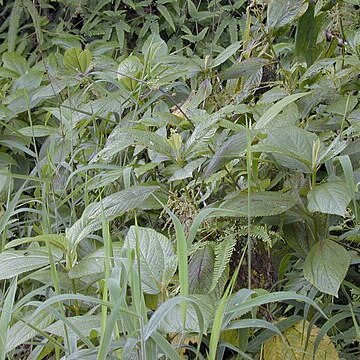Herbs, subshrubs, or shrubs , perennial, rhizomatous, without stinging hairs, sparsely to ± densely pubescent or tomentose with hooked, curved, or straight, nonstinging hairs on all parts of plant. Stems simple to freely branched, erect. Leaves opposite or nearly opposite, or alternate; stipules present. Leaf blades lanceolate to broadly ovate, base rounded to cordate, less often cuneate, margins dentate or serrate, apex acuminate; cystoliths rounded. Inflorescences axillary, spikelike or paniculate. Flowers unisexual, staminate and pistillate flowers on same plant, rarely on different plants, in remote or crowded clusters in same or separate inflorescence; bracts linear. Staminate flowers: tepals 4; stamens 4; pistillode globose. Pistillate flowers: tepals 4, connate, adnate to ovary; staminodes absent; style persistent, elongate; stigma linear, straight or hooked. Achenes sessile, laterally compressed, ovoid, nearly orbicular, or ellipsoid, tightly enclosed by persistent perianth. x = 14.
Monoecious or dioecious, perennial herbs, shrubs or small trees, often pubescent, without irritant hairs. Leaves opposite, often in unequal pairs, or alternate, the upper leaves sometimes grading into bracts, usually petiolate, lamina often asymmetrical, chartaceous, dentate, 3-veined; stipules free or partially connate, usually long-persistent. Inflorescence small axillary clusters, or paniculate or spike-like along a modified stem with flower clusters subtended by bracts. Male flowers: tepals usually 4; stamens usually 4; pistillode present. Female flowers: perianth tubular; orifice contracted, usually toothed; ovary enclosed by perianth; stigma long, linear, long-papillose or if short then papillae restricted to one side of stigma. Fruiting perianth sometimes winged. Achene dull, enclosed by and firmly adnate to fruiting perianth.
Small trees or shrubs, sometimes woody-based herbaceous perennials, monoecious or dioecious, usually ± pubescent. Leaves alternate or opposite, equal-or unequal-sided, dentate, sometimes lobed; stipules free, lateral or ± connate. Inflorescences cymose or racemose, with nearly always unisexual clusters of flowers, sessile along the axes of the inflorescence, bracts small, deciduous. Male flowers (3–)4(–5)-merous; rudimentary ovary present. Female flowers with tubular perianth, often contracted at apex, with 2–4 teeth, enclosing the ovary, of which only the filiform, persistent stigma protrudes. Achene enclosed in the persistent membranous perianth.
Trees, shrubs, or perennial herbs, unarmed and without stinging hairs; leaves opposite or alternate, toothed, 3-nerved, those of the adjacent nodes sometimes unequal and dissimilar; plants monoecious or dioecious, the flowers in globose, usually unisexual clusters in the axils of the leaves or forming a spike; staminate flowers 3 or 4 (rarely 5)-parted; pistillate flowers tubular, contracted at the throat, 2-4-toothed or entire, the stigma filiform, the achene enclosed in the persistent, sometimes enlarged perianth.
Shrubs or subshrubs, monoecious, without stinging hairs or prickles. Leaves alternate, in spirals (to distichous) or (sub)opposite; stipules free; blade pinnately veined to tri(pli)nerved. Inflorescences bisexual (or unisexual?), (sub)sessile, (sub)capitate glomerules with (sub)sessile flowers. Staminate flowers: tepals 3, basally connate; stamens 3. Pistillate flowers: perianth tubular with a 2-toothed apex; stigma filiform, persistent. Achene enclosed by a dry fruiting perianth.
Fls unisexual, in axillary simple to compound glomerules. ♂ with 3-5-partite per., segs valvate; stamens 3-5, inflexed in bud, opp. segs; ovary rud. ♀ with 2-4-toothed tubular per. Ovary sessile or stipitate; style filiform, persistent; ovule 1, erect. Achene invested by persistent per. Monoec. or dioec. trees with alt. or opp., toothed, stipulate lvs. About 75 spp., mainly tropical; the N.Z. sp. endemic to Kermadec Is.
Monoecious or dioecious; male fls minute, with 4-parted cal and 4 stamens; female fls with tubular, flattened to ovoid cal minutely 2–4-toothed at the summit; ovary enclosed by the cal; style filiform, exsert; fr an achene surrounded by the accrescent cal, the latter narrowly 2 winged; style persistent; herbs, shrubs, or small trees with opposite or alternate lvs and axillary infls. 100, warm reg.
Female flowers with tubular perianths, constricted and 2–4-toothed at the apices, completely enclosing the ovaries. Style filiform, not articulated, with a one-sided filiform stigma.
Inflorescences axillary, usually spike-like, with the flowers gathered in unisexual glomerules along the inflorescence axis (rarely sessile and globular); bracts small, deciduous.
Leaves alternate or opposite, petiolate, lamina triplinerved, equal-or unequal-sided, dentate sometimes lobed; stipules lateral, free or ± connate.
Shrubs or small trees, sometimes woody-based herbaceous perennials, monoecious or dioecious, usually ± pubescent, stinging hairs absent.
Male flowers (3)4(5)-merous with membranaceous tepals, rudimentary ovaries present or absent.
Achene completely enclosed in and partly adnate to the persistent perianth.
Cystoliths dot-like.

